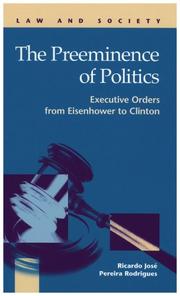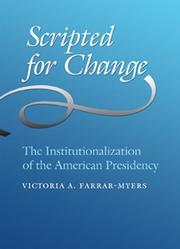| Listing 1 - 10 of 89 | << page >> |
Sort by
|
Book
Year: 2007 Publisher: Washington : Congressional Research Service,
Abstract | Keywords | Export | Availability | Bookmark
 Loading...
Loading...Choose an application
- Reference Manager
- EndNote
- RefWorks (Direct export to RefWorks)
From the earliest days of the federal government, Presidents, exercising magisterial or executive power not unlike that of a monarch, from time to time have issued directives establishing new policy, decreeing the commencement or cessation of some action, or ordaining that notice be given to some declaration. The instruments used by Presidents in these regards have come to be known by various names, and some have prescribed forms and purposes. Executive orders and proclamations are probably two of the best-known types, largely because of their long-standing use and publication in the Federal Register and the Code of Federal Regulations. Others are less familiar, some because they are cloaked in official secrecy. There is, as well, the oral presidential directive, the sense of which is captured in the announcement that records what the President has prescribed or instructed. This report provides an overview of the different kinds of directives that have primarily been utilized by twentieth-century Presidents. It also presents background on the historical development, accounting, use, and effect of such directives.
Book
Year: 2007 Publisher: Washington : Congressional Research Service,
Abstract | Keywords | Export | Availability | Bookmark
 Loading...
Loading...Choose an application
- Reference Manager
- EndNote
- RefWorks (Direct export to RefWorks)
From the earliest days of the federal government, Presidents, exercising magisterial or executive power not unlike that of a monarch, from time to time have issued directives establishing new policy, decreeing the commencement or cessation of some action, or ordaining that notice be given to some declaration. The instruments used by Presidents in these regards have come to be known by various names, and some have prescribed forms and purposes. Executive orders and proclamations are probably two of the best-known types, largely because of their long-standing use and publication in the Federal Register and the Code of Federal Regulations. Others are less familiar, some because they are cloaked in official secrecy. There is, as well, the oral presidential directive, the sense of which is captured in the announcement that records what the President has prescribed or instructed. This report provides an overview of the different kinds of directives that have primarily been utilized by twentieth-century Presidents. It also presents background on the historical development, accounting, use, and effect of such directives.

ISBN: 1593323042 9781593323042 9781593322120 1593322127 Year: 2007 Publisher: New York LFB Scholarly Pub.
Abstract | Keywords | Export | Availability | Bookmark
 Loading...
Loading...Choose an application
- Reference Manager
- EndNote
- RefWorks (Direct export to RefWorks)
Executive orders --- Executive power --- Presidents --- Powers
Book
Year: 2007 Publisher: Washington, Distric of Columbia : Congressional Research Service,
Abstract | Keywords | Export | Availability | Bookmark
 Loading...
Loading...Choose an application
- Reference Manager
- EndNote
- RefWorks (Direct export to RefWorks)
During the 110th Congress, the House of Representatives, the Senate, and the George W. Bush Administration have defined terms like congressional earmark, congressionally directed spending item, and earmark, and have provided some direction for how congressionally originated earmarks, according to these definitions, are to be handled. This report focuses on Bush Administration policy regarding earmarks originated by Congress and related issues. Specific definitions for the term earmark (and related terms, like congressional earmark, presidential earmark, and others) vary considerably and are controversial. Nevertheless, all of the terms relate to the use of discretion to allocate particularized benefits to one or more specific purposes, entities, or geographic areas. Some earmarks have the force of law, and others do not. Practices like earmarking have been used for decades, if not centuries, to make decisions regarding the allocation of public resources, but concerns also have been expressed. At the same time, Congress, its Members, and Presidents have asserted the prerogatives of their constitutional and statutory authorities and pursued their budget policy preferences. In January 2008, the President announced he would veto future appropriations bills that did not cut the number and funding of Administration-identified earmarks by half, relative to FY2008. The President also issued Executive Order (E.O.) 13457, which directed that agencies "should not" fund non-statutory earmarks, except under some conditions. These are the latest in a series of developments that began in January 2007, when the President proposed that Congress should (1) cut the number and funding of congressionally originated earmarks by at least half for FY2008 appropriations, relative to FY2005, and (2) place them only in statutory text, not report language. In January 2007, the Administration issued its own definition of earmark, whose language (and perhaps meaning) evolved over time in Office of Management and Budget (OMB) memoranda. A final definition appears to have been established in E.O. 13457, but its meaning probably is informed by the evolution and contents of previously articulated definitions. Later, OMB established an "Earmarks" website, containing a database of Administration-identified earmarks, to track congressional action. Potential related issues for Congress involve, generally, roles and responsibilities for Congress, the President, agencies, and the public in the U.S. political system; defining, identifying, and overseeing earmarks; the executive order; the "Earmarks" website and database; and potential representational consequences. This report emphasizes analysis of E.O. 13457. For a legal analysis of E.O. 13457, see CRS Report RL34373, Earmarks Executive Order: Legal Issues, by Thomas J. Nicola and T.J. Halstead. This report will be updated as events warrant.
Book
Year: 2007 Publisher: Washington, Distric of Columbia : Congressional Research Service,
Abstract | Keywords | Export | Availability | Bookmark
 Loading...
Loading...Choose an application
- Reference Manager
- EndNote
- RefWorks (Direct export to RefWorks)
During the 110th Congress, the House of Representatives, the Senate, and the George W. Bush Administration have defined terms like congressional earmark, congressionally directed spending item, and earmark, and have provided some direction for how congressionally originated earmarks, according to these definitions, are to be handled. This report focuses on Bush Administration policy regarding earmarks originated by Congress and related issues. Specific definitions for the term earmark (and related terms, like congressional earmark, presidential earmark, and others) vary considerably and are controversial. Nevertheless, all of the terms relate to the use of discretion to allocate particularized benefits to one or more specific purposes, entities, or geographic areas. Some earmarks have the force of law, and others do not. Practices like earmarking have been used for decades, if not centuries, to make decisions regarding the allocation of public resources, but concerns also have been expressed. At the same time, Congress, its Members, and Presidents have asserted the prerogatives of their constitutional and statutory authorities and pursued their budget policy preferences. In January 2008, the President announced he would veto future appropriations bills that did not cut the number and funding of Administration-identified earmarks by half, relative to FY2008. The President also issued Executive Order (E.O.) 13457, which directed that agencies "should not" fund non-statutory earmarks, except under some conditions. These are the latest in a series of developments that began in January 2007, when the President proposed that Congress should (1) cut the number and funding of congressionally originated earmarks by at least half for FY2008 appropriations, relative to FY2005, and (2) place them only in statutory text, not report language. In January 2007, the Administration issued its own definition of earmark, whose language (and perhaps meaning) evolved over time in Office of Management and Budget (OMB) memoranda. A final definition appears to have been established in E.O. 13457, but its meaning probably is informed by the evolution and contents of previously articulated definitions. Later, OMB established an "Earmarks" website, containing a database of Administration-identified earmarks, to track congressional action. Potential related issues for Congress involve, generally, roles and responsibilities for Congress, the President, agencies, and the public in the U.S. political system; defining, identifying, and overseeing earmarks; the executive order; the "Earmarks" website and database; and potential representational consequences. This report emphasizes analysis of E.O. 13457. For a legal analysis of E.O. 13457, see CRS Report RL34373, Earmarks Executive Order: Legal Issues, by Thomas J. Nicola and T.J. Halstead. This report will be updated as events warrant.

ISBN: 0199367094 1281163171 9786611163174 0198041780 1435600967 9780198041788 0195306090 9780195306095 6611163174 9780199839889 0199839883 Year: 2007 Publisher: Oxford ; New York : Oxford University Press,
Abstract | Keywords | Export | Availability | Bookmark
 Loading...
Loading...Choose an application
- Reference Manager
- EndNote
- RefWorks (Direct export to RefWorks)
Once a sleeping giant, China today is the world's fastest growing economy--the leading manufacturer of cell phones, laptop computers, and digital cameras--a dramatic turn-around that alarms many Westerners. But in China: The Fragile Superpower, Susan L. Shirk opens up the black box of Chinese politics and finds that the real danger lies elsewhere--not in China's astonishing growth, but in the deep insecurity of its leaders. China's leaders face a troubling paradox: the more developed and prosperous the country becomes, the more insecure and threatened they feel. Shirk, a former Deputy Assistan
Nationalism --- Presidents --- Executive power --- Powers --- China --- Politics and government

ISBN: 129905370X 1603444637 9781603444637 9781299053700 9781585445851 1585445851 Year: 2007 Publisher: College Station : Texas A&M University Press,
Abstract | Keywords | Export | Availability | Bookmark
 Loading...
Loading...Choose an application
- Reference Manager
- EndNote
- RefWorks (Direct export to RefWorks)
Presidents --- Executive power --- United States --- Politics and government.
Book
Year: 2007
Abstract | Keywords | Export | Availability | Bookmark
 Loading...
Loading...Choose an application
- Reference Manager
- EndNote
- RefWorks (Direct export to RefWorks)
Administrative procedure --- Administrative regulation drafting --- Executive power --- Government productivity --- United States. --- Rules and practice.
Book
Year: 2007
Abstract | Keywords | Export | Availability | Bookmark
 Loading...
Loading...Choose an application
- Reference Manager
- EndNote
- RefWorks (Direct export to RefWorks)
War on Terrorism, 2001-2009. --- Executive power --- Terrorism --- Prevention. --- United States.
Book
Year: 2007
Abstract | Keywords | Export | Availability | Bookmark
 Loading...
Loading...Choose an application
- Reference Manager
- EndNote
- RefWorks (Direct export to RefWorks)
Administrative procedure --- Administrative regulation drafting --- Executive power --- Government productivity --- United States. --- Rules and practice.
| Listing 1 - 10 of 89 | << page >> |
Sort by
|

 Search
Search Feedback
Feedback About
About Help
Help News
News